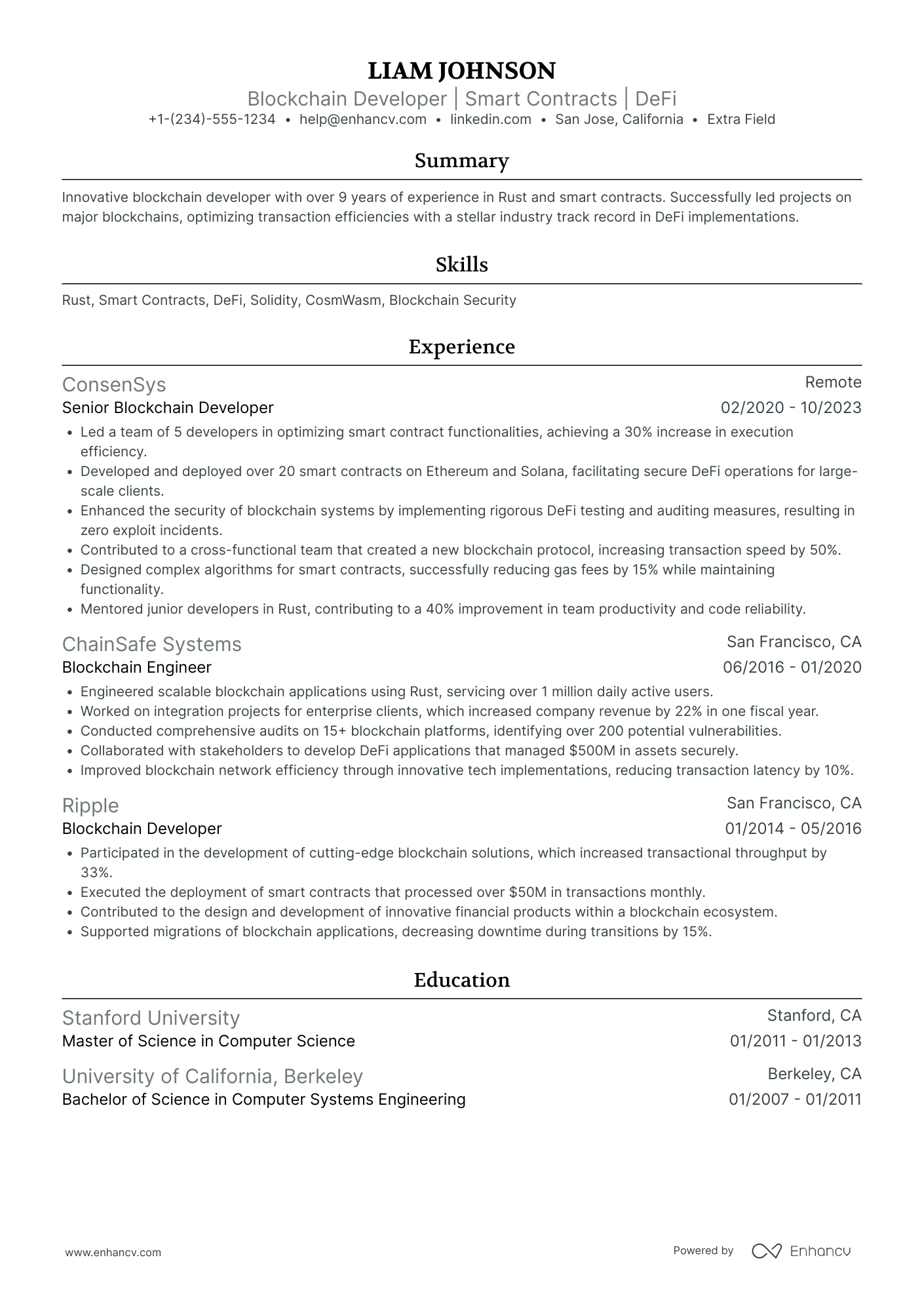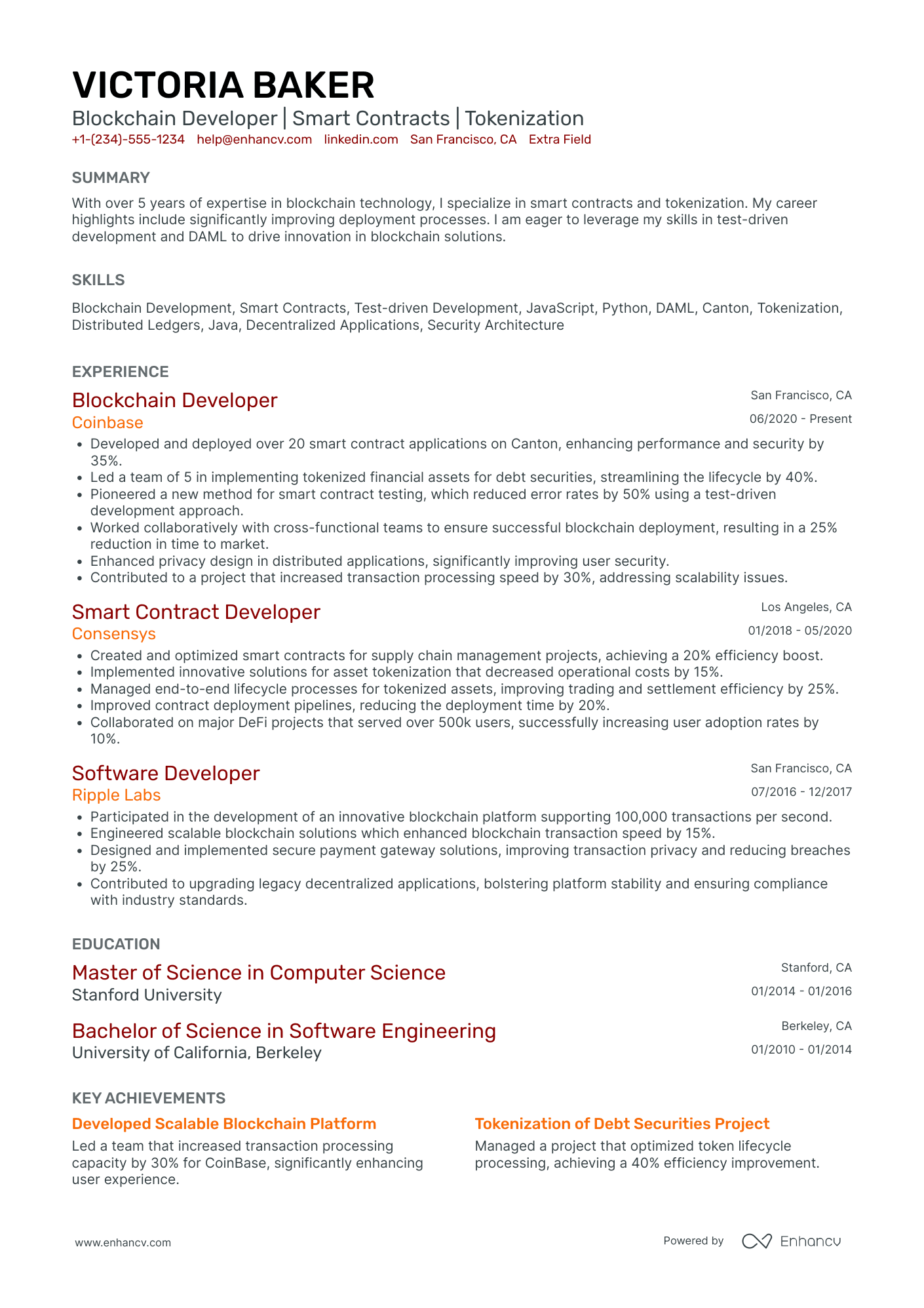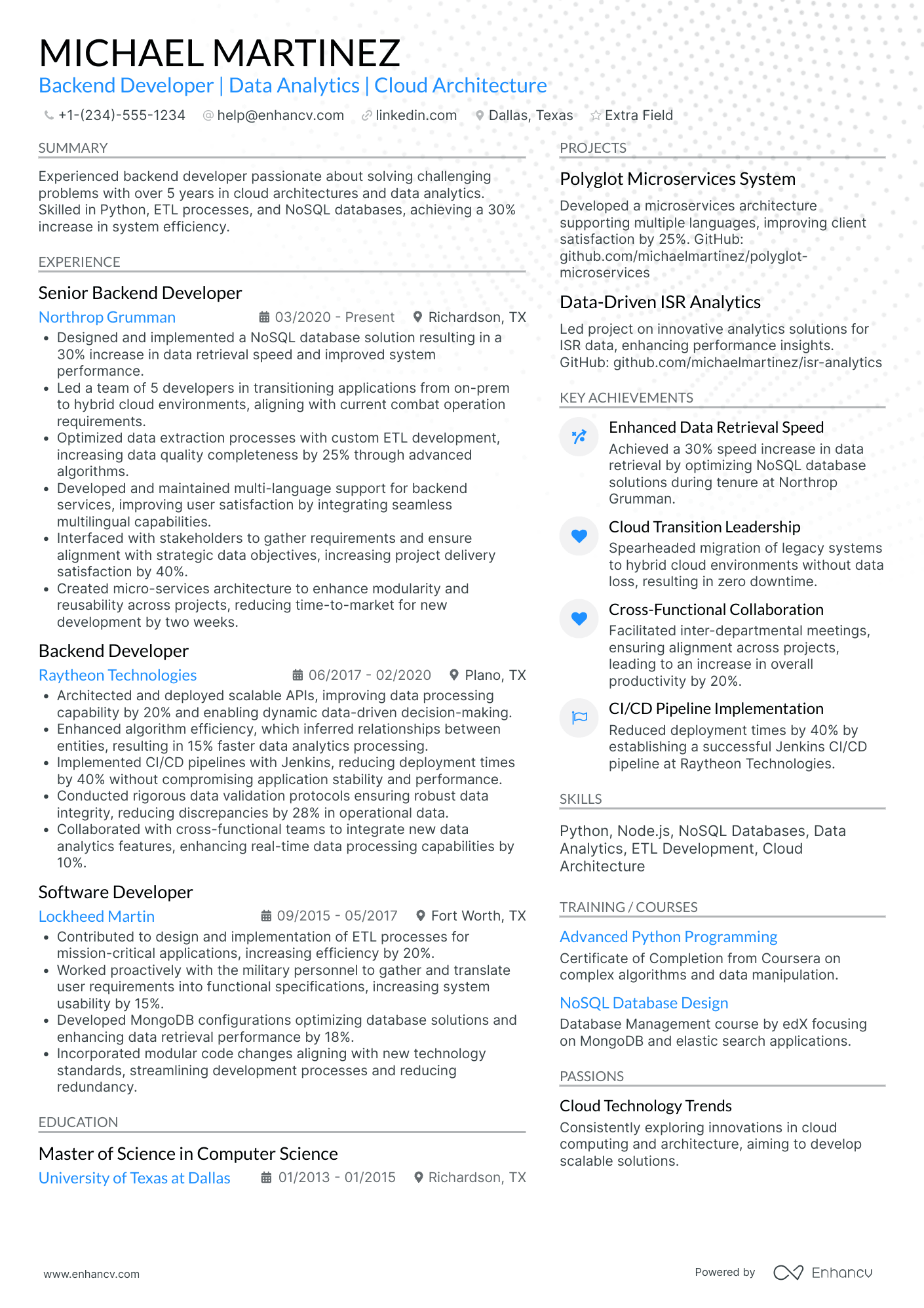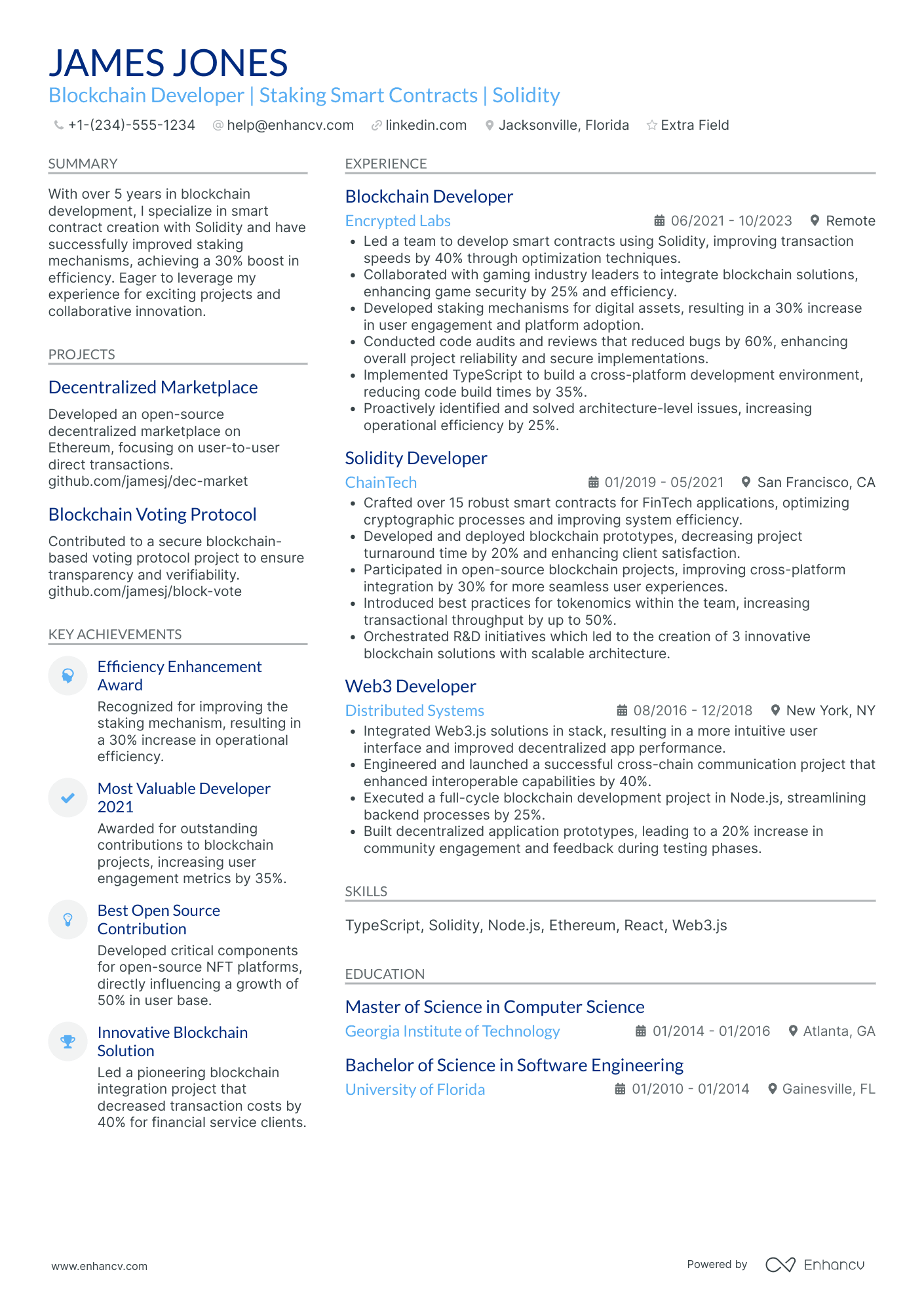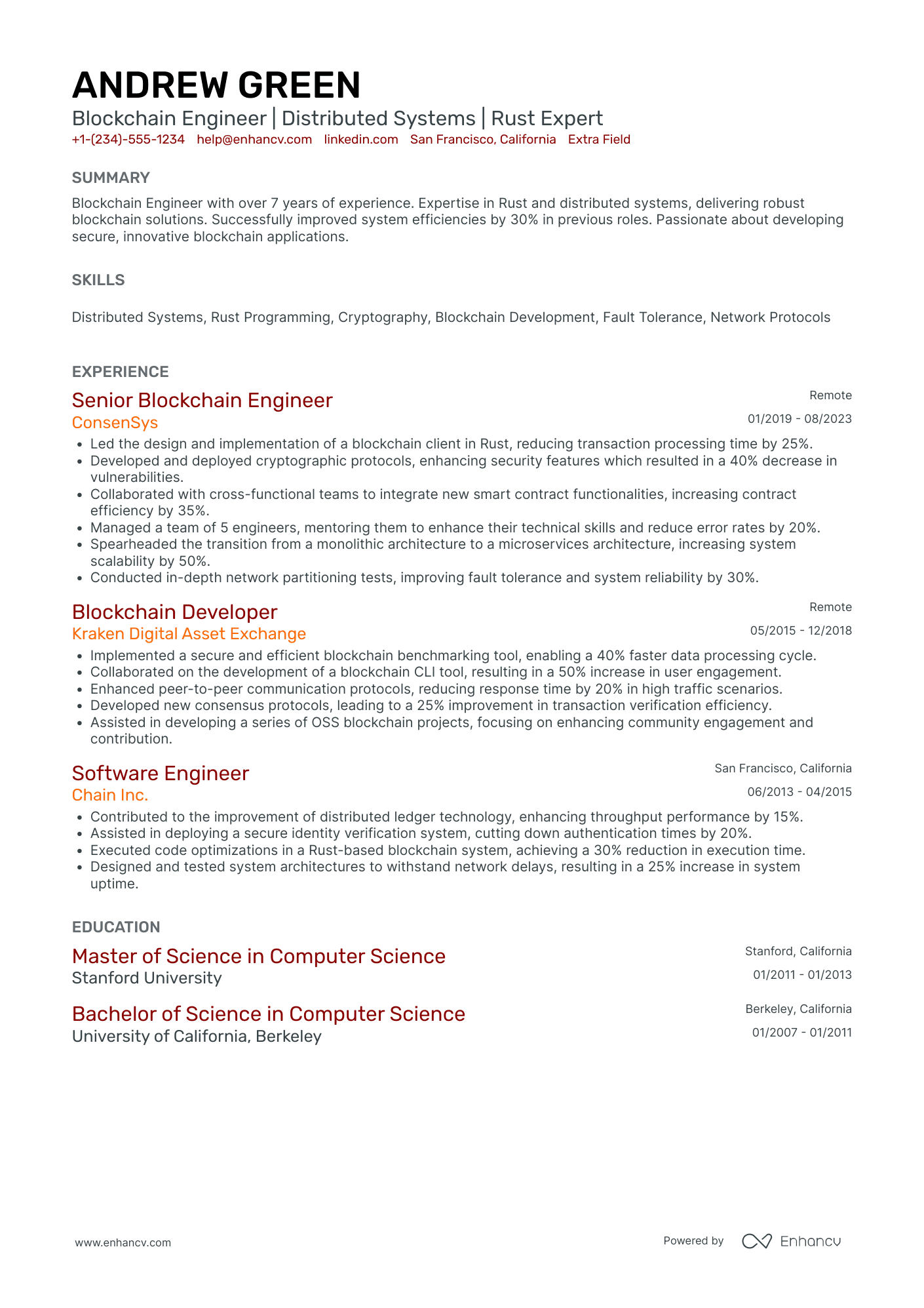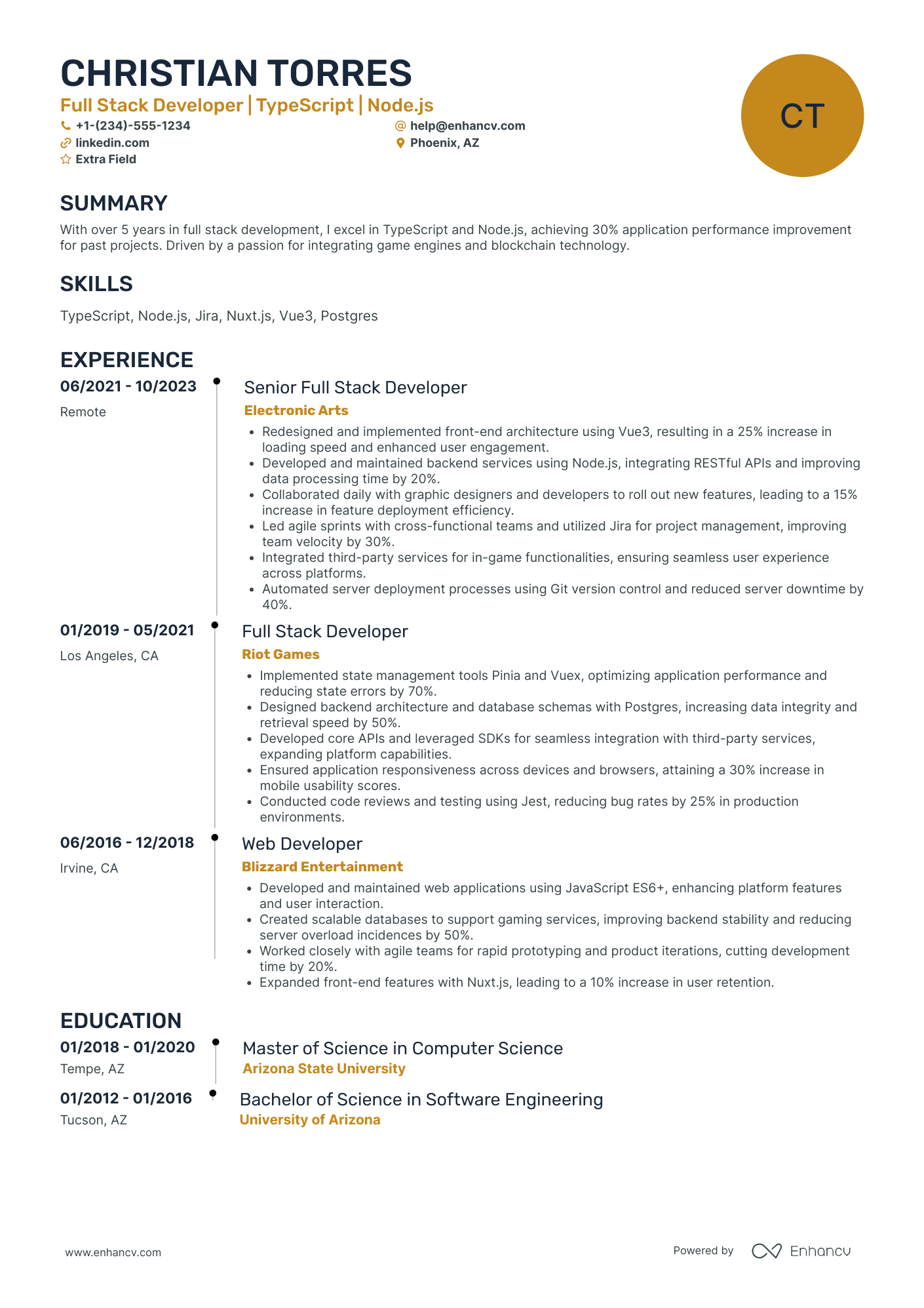Blockchain technology is a relatively new field that began with Satoshi Nakamoto’s conceptualization of distributed blockchains in his 2008 white paper, A Peer to Peer Electronic Cash System.
The newness of this technology presents some unique challenges for developers who are looking for a new blockchain developer role. The trick is to show recruiters and hiring teams that you have the skills necessary by demonstrating your technical skills and financial knowledge through related paid work and personal projects.
In this guide, we will cover the common issues developers face when building their resumes and use real-world examples to show you how to:
- Highlight advanced blockchain development education
- Showcase a deep understanding of financial concepts and specific programming languages
- Detail knowledge and experience with decentralized applications (DApps) and open source like Ethereum, Hyperledger, and Smart Contracts
- Demonstrate various blockchain development projects through a digital portfolio
We will take a deep dive into each section to show how you can maximize the effectiveness of your resume in a concise manner.
If this guide is not quite right for your career goals, we have other guides for similar roles that may be better suited for you:
- Node.js Developer resume
- .Net Full Stack Developer resume
- Senior Developer resume
- Ruby On Rails Developer resume
- Python Developer resume
One of the first things we need to discuss is the proper format for your resume.
How to format a blockchain developer resume
When it comes to resumes, formatting is relatively easy but very important. A poorly formatted resume will likely give you zero callbacks.
Recruiters and HR teams expect resumes to follow a specific format:
- 1-inch margins on all sides
- Single line spacing
- Using a serif or sans serif font
Most of these settings are automatically set when you create a new document, so there is nothing to change. What you do want to double-check is your font settings. The font size should be between 10-12 points using standard black as the color.
The only time you want to use a different font color is when you use a colored background for a side section in a two-column resume template. We’ll talk a little more about that later on.
For many years, the go-to fonts for resumes were Arial, Courier, and Times New Roman. While these are fine to use and give your resume a more classical look, for technical resumes like a blockchain developer, you want to go with a cleaner, more modern resume.
When listing your work and education, you want to list each entry in a reverse chronological format. This is the standard way to list all dated entries in a resume and puts your most recent accomplishments at the top of the list.
While you are working on your resume, you can save it in whatever format you choose, but when submitting it to a job post, send it using the PDF format (.pdf). This type will preserve the format of your resume no matter what operating system the company is using.
Enhancv resume templates come preset with all of the above settings and use more modern fonts, like Exo 2, Volkhov, Lato, Rubik, and Monserrat. They come in a range of styles, from modern to traditional, including single and two-column formats.
Be aware of location-based layout differences – Canadian resumes, for instance, might differ in format.
If you want to see how your current resume compares to other blockchain developer resumes, our resume checker will evaluate your resume and give you tips on how to improve it.
The top sections on a blockchain developer resume:
- Technical skills: Showcase knowledge of different programming languages and specific software.
- Resume experience: Detail relevant work experience that demonstrates your knowledge of smart contracts, blockchain architecture, and working in a team environment.
- Certification and continuing education: Highlight advanced education through workshops, certifications, and continuing education programs.
- Resume summary: A brief summary of your career to date that quantifies specific metrics and your development accomplishments.
- Project portfolio: Include a link to a professional portfolio where hiring managers can view token creation, DApp builds, and other open-source projects.
When filling out each section, keep in mind HR staff look for specific keywords and phrases on each resume. You want to tailor your resume to match what they are looking for.
What recruiters want to see on your resume:
- Proficiency in blockchain platforms: You want to demonstrate your effectiveness in developing and managing blockchain systems.
- An understanding of cryptography: Security is a top priority in blockchain architecture, and recruiters want to see quantifiable evidence of your cryptology skills.
- Experience with Smart Contracts: The ability to create and implement Smart Contracts is an essential skill for all blockchain developers.
- Deep knowledge of blockchain programming languages: Your resume needs to highlight experience with Python, JavaScript, Ethereum Solidarity, and other programming languages to showcase a wide depth of technical skills.
- Team-oriented: Blockchain development is a team effort, and you need to demonstrate your interpersonal and leadership skills.
Applicant tracking systems
There may be some confusion about what applicant tracking systems (ATS) do and how they analyze resumes. The popularity of this software is growing as it helps recruiters and HR teams sift through the hundreds of resumes they receive for a single position.
Imagine looking for a single needle that is slightly different than the rest in a big pile of needles, and you get the picture.
Recruiters will enter specific keywords and phrases as a base for what the system should highlight. A company looking for a blockchain developer with experience in JavaScript and C++ will enter those words as a search criteria.
While you don’t need to match them word-for-word, you do want to try and come close to how they write it.
Also, don’t fall for some of the common ATS myths, like the system rejecting two-column formats. The software accepts all standard resume formats.
How to write your blockchain developer resume experience
Now let’s get to the meat and potatoes of your resume. This is the section that HR teams study very closely, so you need to pay close attention to how you list each entry.
The resume experience section includes your current and past professional blockchain development experience, along with other development jobs in the backend development or financial sector. Each job you list should answer the following question:
How did you use your financial knowledge and technical and interpersonal skills to create beneficial results?
Only list up to three jobs, starting with your most current position. The reverse chronological format is the standard way to list past work experience and education.
Each job entry needs the company name and location, dates of employment, and 4-8 bullet points detailing the work you performed.
Let’s take a look at a real-world blockchain developer work experience example to see how effective, or not so effective, this section can be:
- •Worked with product and development teams to improve efficiency of the platform
- •Reused cross-chain libraries to improve framework performance
- •Developed new tools and integrated them into the platform
- •Developed the backend to intersect with new technologies and financial platforms
- •Participated in several open source community projects, met with stakeholders, and mentored and tutored junior developers
Does this example answer the question about this person’s ability? Not really. It gives vague descriptions of the tools and responsibilities a blockchain developer would use, but this example doesn’t show any actionable results.
We are left with more questions than answers. This is where many blockchain developers fall short when listing past work experience.
Let’s try this again but with some more specifics:
- •Closely collaborated with the product and dev teams to improve the efficiency of the platform by 25%
- •Built 5 reusable cross-chain libraries, which led to a 40% decrease in production times
- •Participated in the development of 3 new tools and integrated them into the platform
- •Assisted in developing the backend framework that became the foundation for the intersection between Web3 and FinTech
- •Participated in 5+ open source community projects, met with stakeholders, and mentored and tutored 3 junior developers
We finally get the answers we are seeking! This example does a great job of showing leadership abilities, interpersonal skills, and actionable results that detail how their work improved the company’s blockchain performance.
This example does a good job of showing how you can:
- Quantifying the impact on efficiency, production times, and other metrics
- Highlight leadership and mentoring abilities
- List specific applications you have direct experience in
Each entry should include this information along with other details that reflect your experience and passion for blockchain development.
If your resume experience does not quite live up to this example, we’ll go over how you can quantify other metrics next.
How to quantify impact on your resume
blockchain developers are the unseen heroes of cryptocurrency and are essential for keeping financial transactions safe from prying eyes. How can you quantify what goes on behind the scenes of blockchain development?
Using numbers and percentages in your resume is the best way to demonstrate how you used your experience and coding skills to develop new smart contracts, embedded widgets, and decentralized apps.
Look at these examples of quantifying various blockchain metrics to give you an idea of how you can create an attention-getting resume:
- Smart Contracts: “Devised an Ethereum smart contract and Rails website that allowed over 3.9K developers to sell software licenses using 17 embeddable widgets.”
- Proficiency in blockchain platforms: “Boosted efficiency by 35% through incorporating different consensus algorithms, such as Proof-of-Work (PoW), Proof-of-Stake (PoS), and Delegated Proof-of-Stake (DPoS).”
- Mentoring and leadership: “Led a team of 2 developers to develop a front-end reporting system for the company’s internal clients.”
- Increases in system efficiency: “Reduced the time to diagnose customers’ server issues from 72 hours to 45 minutes, slashing $200K yearly in support costs.”
- Security audits: “Built a private blockchain using Hyperledger Fabric 1.0 that enhanced data security and reduced risk exposure by 93%.”
- Bug fixes on blockchain applications: “Increased the 180-character display name limit in a popular app, which impacted 2M users in three days.”
- Blockchain Development languages: “Developed 16 decentralized social media web applications using React, CSS, Bootstrap, and web3.js/Ethers for integrated Ethereum.”
- Cost reductions: “Improved gas savings from token transfers by 85% using encoding design inspired by the Balancer Labs Protocol and adding an internal balance.”
- Increased profits: “Played a pivotal role in the design and launch of a tokenization platform that raised $10M during its initial coin offering (ICO), exceeding fundraising target by 25% and establishing a new benchmark for the company.”
Try to focus on quantifying the metrics that the job post mentions. For instance, if the post states:
You want to focus on quantifying your experience with the specified platform: “Developed and implemented Proof-of-Stake mechanism using the Solana platform to provide smart contract functionally.”
A targeted resume will increase your chances of making an excellent first impression on your future employer.
How do I write a blockchain developer resume with no experience
If this is your first time applying for a blockchain developer role, don’t worry about not having any real-world experience as a blockchain developer. This is very common since this technology is still fairly new.
When listing your past work experience, only include those jobs where you:
- Developed front and back-end systems for decentralized apps and widgets
- Integrated blockchain technology into an existing system
- Implemented best security practices that reduced security threats
- Researched and developed new technologies, trends, and tools
- Set up and maintained blockchain networks and nodes
- Implemented fixes and bug repairs to improve system performance
- Worked within a cross-team environment to develop new programs or procedures
When including past work experience, only include up to 3 jobs. Any more than that, and you run the risk of going over that 2-page limit. The jobs you chose to list should show a clear progression towards a blockchain developer, like so:
Choosing between a single and two-column resume template
There is some debate over which resume template format is best. Single or double columns. Because blockchain developers generally have 5-10+ years of experience, a two-column template is preferred.
It allows for more information to appear on a single page. Developers with multiple skills to list can show off more of their talents, passions, and advanced education. Remember our earlier example from XXX XXX? Their resume is a good example of how a two-column template can display all information with minimal scrolling.
If you do go with a two-column template and want to add some color, choose a dark contrasting color for the smaller column. Avoid bright colors, as it can be too distracting. If you do change the background color, be sure to change the color of your font to white so it is still readable.
How to list your hard skills and soft skills on your resume
Blockchain development is a very technical position that requires advanced skills in various programming languages, coding, and cryptology. Developers also need to demonstrate their ability to work with a diverse group of people and work well under tight deadlines.
What are hard and soft skills? Soft skills are those skills you pick up through daily interactions with your friends, family, co-workers, and complete strangers. They include personal skills like emotional intelligence, a passion for coding, and the ability to come up with out-of-the-box solutions.
Hard skills cover technical and business-related skills that you learn through education and on-the-job training. They include knowledge of industry-related apps, cryptocurrency, cross-chain technologies, and financial data.
Best hard skills for your blockchain developer resume
- Blockchain architecture
- Ethereum Platform
- Hyperledger Fabric
- Corda R3
- Solidity
- Go Language
- Python
- JavaScript
- Node.js
- Cryptography
- Distributed Ledger Technology
- Smart Contracts Development
- Data structures
- Consensus algorithms
- Decentralized applications (DApps)
- Cross-chain technology
- Security protocols
- APIs
- Rust programming
You also want to demonstrate your critical thinking and leadership skills, as many positions work within a cross-functional team that develops complex solutions to protect financial assets.
Consider adding some of the following skills:
Best soft skills for your blockchain developer resume
- Problem solving
- Analytical thinking
- Strong communications
- Creativity
- Teamwork
- Adaptability
- Time management
- Attention to detail
- Proactivity
- Integrity
- Negotiation
- Critical thinking
- Decision making
- Learning ability
- Presentation skills
- Networking
- Patience
- Innovation
Let’s take a few minutes to talk about adding post-secondary education and advanced training to your resume. This next section is required, no matter how long ago you graduated from college.
How to list your certifications and education on your resume
The education section is very important for blockchain developers as it shows a basic foundation of knowledge that all developers need. In addition to listing post-secondary education, you also want to include more advanced training through certifications, workshops, and online boot camps.
When listing your education, you only need to include the degree type, school name and location, and graduation or attendance dates, like so:
Technical certifications are a blockchain developer's best friend and can do a lot for their career. Because this is such a new technology, recruiters want to see advanced training beyond the standard bachelor’s or master’s degree.
When including your certifications, be sure to include the name of the certification and the institution that provided the training:
Lastly, if you have attended any workshops or continuing education courses, you want to include those as well.
These last two sections fit nicely as a side column in a two-column resume template.
If you want to boost your skills and earning potential, consider one of these blockchain developer certifications:
Best certifications for your blockchain developer resume
In addition to the above certifications, you can sign up for a blockchain developer boot camp. These training camps are perfect for learning and fine-tuning technical skills, networking with other blockchain developers, and learning about new job opportunities before they hit the open job market.
The top boot camps for blockchain developers include:
How to write your blockchain developer resume summary or objective
The way you write this next section will depend on how much relevant work experience you have. A resume summary is designed for more experienced developers with several years of experience and multiple jobs and development projects. It summarizes your career to date and how your skills can benefit future employers.
A resume objective is for developers who are fresh out of school and looking for their first developer role. It is also for those who are switching to a new career or technology field. It includes your career objectives and what you are doing to reach those goals.
Let’s take a look at a real-world blockchain developer resume summary to see how valuable this section can bring to your resume:
What do you think? Does this example do a good job of summarizing this person’s experience? Does it answer the question, “How can they benefit our company?”
It does, but in a very non-descript kind of way. Saying you are a “resourceful blockchain developer with experience” is not enough. This is a highly skilled position and requires a minimum of 3-5 years of experience, and you want to clearly state the number of years you worked as a developer.
They do a good job of talking about which technologies they are familiar with but don’t back up their ‘extensive knowledge’ by quantifying their achievements. If your work achieved higher profits or faster development times, say so by using numbers and percentages.
Notice how this example uses ‘I am.’ This is acceptable to use and is more of a personal style choice. Try out each style and use the one that you like the most.
Be sure to check your grammar and punctuation before submitting your resume. Little things like ‘Javascript’ instead of “JavaScript’ and ‘blockchain developer’ instead of ‘blockchain developer’ matter.
Let’s try this again:
This example does a better job of showing how to create a concise summary that quantifies your achievements. The summary section is a great place for you to add industry keywords and quantify metrics, such as profit increases, customer growth, and development improvements.
Notice how it mentions the industry type and passion for improving financial infrastructure. This information is very helpful as it points to direct industry experience and the person’s desire to work with FinTech. They also describe how their skill and knowledge led to improved smart contract development, another critical aspect of this industry.
Remember to tailor this section for each job you are applying for. If the job post lists blockchain security as their main responsibility, you want to quantify that metric.
Optimize your resume summary and objective for ATS
Drop your resume here or choose a file.
PDF & DOCX only. Max 2MB file size.
Additional sections for a blockchain developer resume
So far, we have focused on the main sections of your resume: the resume summary, resume experience, education, and hard and soft skills. This does not paint a clear picture of all of your skills and experience.
You can highlight additional skills, strengths, and other relevant information through side sections that will round out your resume.
Is the company you are applying for multi-national? In that case, you want to show your proficiency in a second language.
In each job post, they will list essential skills and knowledge of blockchain developer platforms like Ethereum, Solana, and Binance. While you want to feature this knowledge in your resume experience section, you also want to highlight additional relevant knowledge.
You can use one of Enhancv custom side sections to list other software and technologies you have experience with that aren’t listed in the job post but still demonstrate relevant skills:
Blockchain developers work with a diverse group of people, and it can benefit you to showcase more soft skills, especially if the job description asks for leadership or customer relations experience.
Consider adding these other resume sections to complete your resume:
- Publications and speaking engagements
- Bootcamps and workshops
- Personal code development projects
- Membership in professional associations
Adding a digital portfolio to your blockchain developer resume
As a blockchain developer, you will develop a number of smart contracts, DApps, widgets, and other projects. If you are applying for a new job, you can give recruiters a visual demonstration of your abilities.
Coding is an art form, and having a digital portfolio allows you to show off multiple projects in one place. Your portfolio can include:
- Blockchain protocols and networks
- Tokenomics models
- Security measures
- Blockchain data analytics
- NFT projects
- Open source contributions
Where can you add a portfolio link? The Header section is perfectly suited for this:
If you need to build a portfolio, consider using one of the following portfolio websites:
Key takeaways
Blockchain development is a booming industry, with an expected 25% growth rate between now and 2030. That means there will be well over two million developer roles in the near future.
Through our journey together, we learned how to avoid the common mistakes and pitfalls that developers make when crafting their resumes, like:
- Tailoring the resume to include keywords listed in the job post
- Highlighting a mix of business, technical, financial, and personal skills using various resume sections
- Quantifying industry-specific metrics in the resume summary and experience sections
- Including post-secondary and advanced training through certifications, boot camps, and online workshops
- Listing memberships in professional associations and local networking groups to show you are active within the community
Blockchain Developer resume examples
By Experience
By Role
